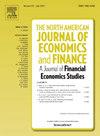解密银行业的股市动态:短期与长期见解
IF 3.8
3区 经济学
Q1 BUSINESS, FINANCE
North American Journal of Economics and Finance
Pub Date : 2024-11-13
DOI:10.1016/j.najef.2024.102311
引用次数: 0
摘要
全球银行业极端波动和危机的严重程度正在不断升级。在单一时间尺度上运行的传统模型可能会将任何变化误解为长期趋势的变化,从而扭曲市场洞察力。为了解决这个问题,本文在标准隐马尔科夫模型中引入了分层结构,从而能够区分美国银行业的短期和长期趋势。利用 2007 年 1 月 1 日至 2023 年 7 月 31 日两种不同频率的纳斯达克银行股票市场指数数据,我们构建并评估了分层隐马尔可夫模型的不同校准。结果显示了两种长期机制:具有高波动性、不稳定性和负收益的动荡时期,以及普遍稳定的市场。在每种情况下,都能识别出代表短期趋势的两种截然不同的状态,它们在持续性、可能性、预期收益和风险概况方面都存在显著差异。结果表明,投资者应仔细区分这两个层次上的不同状态,以做出明智的投资决策。本文章由计算机程序翻译,如有差异,请以英文原文为准。
Decoding the stock market dynamics in the banking sector: Short versus long-term insights
The severity of extreme fluctuations and crises within the global banking sector is escalating. Conventional models, operating on a single time scale, may misinterpret any shift as a change in the long-term trend, distorting market insights. To address this issue, the present paper introduces a hierarchical structure into the standard hidden Markov model, enabling the differentiation of short and long-term trends within the U.S. banking industry. Using NASDAQ Bank stock market index data from January 1, 2007, to July 31, 2023 at two different frequencies, we construct and evaluate different calibrations of the hierarchical hidden Markov model. Results reveal two long-term regimes: turbulent periods with high volatility, instability, and negative returns, and prevalent stable markets. Within each of them, two distinct states representing short-term trends are identified, exhibiting significant differences in persistence, likelihood, expected returns, and risk profiles. The results show that an investor should carefully differentiate between regimes on both hierarchies to make informed investment decisions.
求助全文
通过发布文献求助,成功后即可免费获取论文全文。
去求助
来源期刊
CiteScore
7.30
自引率
8.30%
发文量
168
期刊介绍:
The focus of the North-American Journal of Economics and Finance is on the economics of integration of goods, services, financial markets, at both regional and global levels with the role of economic policy in that process playing an important role. Both theoretical and empirical papers are welcome. Empirical and policy-related papers that rely on data and the experiences of countries outside North America are also welcome. Papers should offer concrete lessons about the ongoing process of globalization, or policy implications about how governments, domestic or international institutions, can improve the coordination of their activities. Empirical analysis should be capable of replication. Authors of accepted papers will be encouraged to supply data and computer programs.

 求助内容:
求助内容: 应助结果提醒方式:
应助结果提醒方式:


